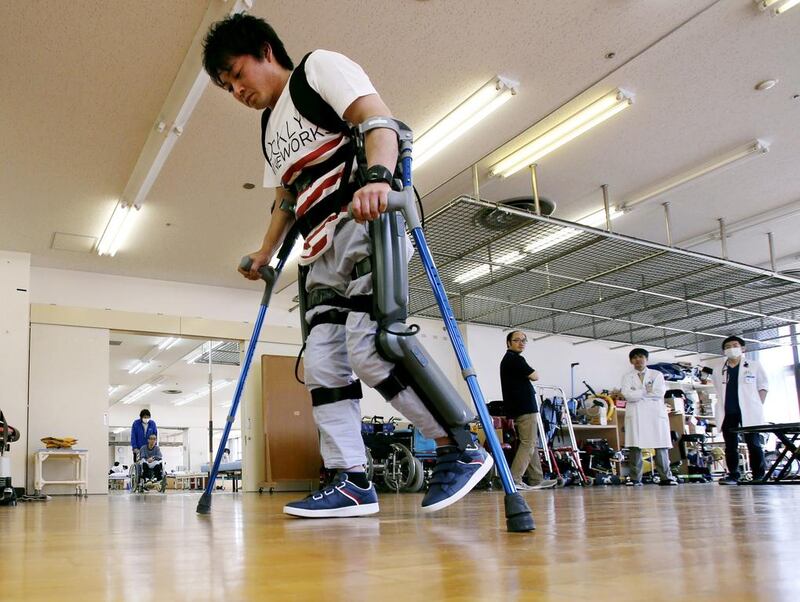ATSUGI, JAPAN // Yuichi Imahata’s 9-year-old daughter is thrilled her dad stands tall above her head. It is an experience that is new to her.
Mr Imahata, 31, has been using a wheelchair to get around for seven years after a serious spinal-cord injury suffered in an accidental fall while working for a transport company. He completely lost sensation in both his legs and was told he would never walk again.
But he is now walking, at times with his little girl laughing beside him, because of a robotic exoskeleton called ReWalk.
The thrill is still limited to a rehabilitation centre in Atsugi city, southwest of Tokyo, where ReWalk is available to a handful of Japanese paraplegics, skirting regulations, in the name of research.
Despite Japan’s prowess in robotics, ReWalk advocates say its wider application here could be stymied by convoluted bureaucracy.
“It’s a wonderful tool for people who sincerely want the joy of standing up,” said Moriyasu Marutani of Kanagawa Rehabilitation Center, who works with Mr Imahata to use ReWalk.
“Safety is the biggest concern for winning its approval for medical use,” he said. “Approval tends to take many years here, and so the hurdle is pretty high.”
ReWalk, an invention of Israeli entrepreneur Amit Goffer, who was paralysed in a 1997 accident, clasps on to the legs and waist. It is designed to create natural walking movements, including standing, sitting and turning through upper-body motion sensors and special software.
Medical experts say its use helps keep organs and bones healthy and also enhances mental well-being.
The product was one of the Israeli technologies highlighted as a symbol of flourishing commercial ties when Japanese prime minister Shinzo Abe met Israeli prime minister Benjamin Netanyahu during Mr Abe’s visit to the Middle East this year.
The distribution effort is going far more smoothly in places such as China than Japan, said Ayumi Hayashida, a spokesman for Japanese robotics maker Yaskawa Electric which is distributing ReWalk in Asia.
Mr Hayashida believes ReWalk is being met by bureaucratic stonewalling that is typical of the frustrations Japanese businesses face in doing something new.
“We boast the No. 1 skill in robotics, but how we can actually use the skills is where we are behind the rest of the world,” he said.
Under the Japanese system, there is a lengthy preliminary vetting process before a formal drug or medical device proposal can be filed. The process has public safety in mind. Japanese drug approvals tend to take longer than the US and Europe but some feel the requirements are overly onerous and ill-suited to new technologies.
Hiroshi Yaginuma, a health ministry official overseeing the approval of medical devices, said ReWalk was not yet being considered for approval, and it was unclear whether it would meet the criteria for a treatment device.
Mr Abe has promised a “robot revolution” including deregulation and research funding to double Japan’s robot market size in manufacturing from US$5 billion (Dh18.4bn) to $10bn a year.
Annual profits from robotics are already $3 billion – or half the global market. “Technology is evolving and it spreads, finding new uses that weren’t anticipated in the beginning,” said Tomotaka Takahashi, creator of Kirobo, the boy-like humanoid that went on the International Space Station.
“It’s truly pathetic when ridiculous regulations get set up, based on irrelevant and negative predictions,” he said of the government approval system which he feels is out of touch with scientific innovation.
Yaskawa has been expanding its lineup to robots that can co-exist with people, helping them get around and assisting in health care.
That area could boom in coming years because of Japan’s aging population.Yaskawa is hoping to fine-tune the $71,600 ReWalk to make it lighter and smaller and hopefully cheaper. Yet even in its current form, the device is freeing for wheelchair users, who can feel confined to a low eye-level.
“I’ve seen Americans using ReWalk on YouTube. They can reach things on shelves,” said Mr Imahata.
His wish is simple.
He dreams of wearing ReWalk to his daughter’s school for the annual athletics event, standing in a crowd of parents, peering with anticipation over shoulders and heads, and catching a glimpse of his girl in action.
* Associated Press





